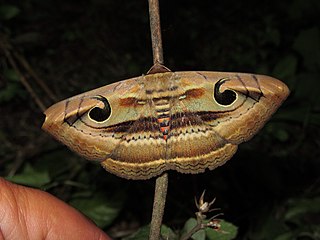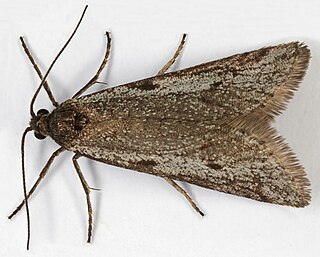
Agrochola lota, the red-line Quaker, is a moth of the family Noctuidae. The species was first described by Carl Alexander Clerck in 1759. It is distributed throughout the whole of Europe except Scandinavia; in Armenia, Asia Minor, and east across the Palearctic to the Altai mountains and western Siberia.It was introduced to Newfoundland. In the Alps, it rises at altitudes of just over 1500 metres.

Archips xylosteana, the variegated golden tortrix or brown oak tortrix, is a moth of the family Tortricidae.

Enarmonia formosana, the cherrybark tortrix or cherry-bark moth, is a small but colorful moth species of the family Tortricidae. It is native to all of northern and western Europe, ranging south to the Maghreb. North of the Alps its range extends eastwards to Siberia and Kazakhstan. Possibly and most likely introduced populations are found in Asia Minor and North America, respectively.

Phytometra viridaria, the small purple-barred, is a moth of the family Erebidae. The species was first described by Carl Alexander Clerck in 1759. It is found in central and southern Europe, Mauritania, Morocco, Algeria, Tunisia, Armenia, Iraq, Iran, Afghanistan, Pakistan, and further east across the Palearctic to southern Siberia.

Anacampsis populella is a moth of the family Gelechiidae, which is native to Europe and has been accidentally introduced to North America. It was first described in 1759 by Carl Alexander Clerck, a Swedish entomologist. The type specimen is from Sweden. The foodplants of the larvae are poplars and willows.

The tortrix moth, genus Pammene, belongs to the tribe Grapholitini of the subfamily Olethreutinae.

Acompsia cinerella, the ash-coloured sober, is a small lepidopteran species of the twirler moth family (Gelechiidae). It is the type species of the genus Acompsia, once assigned to the subfamily Anacampsinae but generally placed in the Dichomeridinae. The species was first described by Carl Alexander Clerck in 1759.

Epinotia nisella is a moth of the family Tortricidae which is found in the Palearctic, Europe and North America. It was first described by Carl Alexander Clerck in 1759.

Spirama retorta, the Indian owlet-moth, is a moth of the family Erebidae. The species was first described by Carl Alexander Clerck in 1764. It is found in China, Korea, Japan (Honshu), India, Nepal, Bangladesh, Thailand, Cambodia, Myanmar, Vietnam, Taiwan, Sri Lanka, Malaysia, the Philippines (Luzon), Indonesia ,Japan.

Pammene populana, the pygmy piercer, is a species of moth of the family Tortricidae. It is found in most of Europe, except Portugal, the Balkan Peninsula and Ukraine. The habitat consists of woodland, marshes, riverbanks, fens and sand dunes.
Dichomeris deltaspis is a moth in the family Gelechiidae. It was described by Edward Meyrick in 1905. It is found in Sri Lanka. The Global Lepidoptera Names Index has this species as a synonym of Dichomeris bisignella.

Endothenia ericetana is a species of moth, belonging to the family Tortricidae first described by Henry Noel Humphreys and John O. Westwood in 1845.

Exapate congelatella is a moth belonging to the family Tortricidae. The species was first described by Carl Alexander Clerck in 1759.

Pammene argyrana is a species of moth belonging to the family Tortricidae.

Pammene gallicana is a moth belonging to the family Tortricidae first described by Achille Guenée in 1845.

Pammene obscurana is a moth belonging to the family Tortricidae. The species was first described by James Francis Stephens in 1834.

Pammene ochsenheimeriana is a moth belonging to the family Tortricidae. The species was first described by Friederike Lienig and Philipp Christoph Zeller in 1846.

Pammene splendidulana is a moth belonging to the family Tortricidae. The species was first described by Achille Guenée in 1845.
Pammene spiniana is a moth belonging to the family Tortricidae. The species was first described by Philogène Auguste Joseph Duponchel in 1842.

















